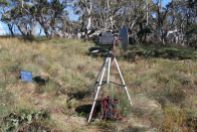As we had scheduled a house move one week prior to the January 17th VHF Field Day, I had to set aside the equipment needed for the field day so it wouldn’t get packed up and be lost for months, which can happen when you move house.
The antennas were no problem as I had to move them on the roof racks of the car. The cables were a possible problem, as were the connectors, camping gear, tent/poles, generator, power cables and distribution boards, power cables for radios, the radios themselves.
The one thing I could not put on hold was myself and I had worked very hard for 5 days straight packing and carrying boxes of household goods. The last move took ages and I had several weekends to sort through 3 garages and dispose of unwanted stuff. This time was a bit better, there was only one garage.
The upshot was that with some encouragement from Dale VK1DSH I did find the energy to pack the car early on Saturday morning and head up to Mt Ginini, a 70 km, 90 minute trip from the new QTH. It took a bit longer as I called in at the bakery and the supermarket for some essential supplies on the way.
We got the station set up by about 3pm and logged our first contacts on all bands. Right away there seemed to be antenna problems on 52 and 432 MHz. Both antennas came down, connectors checked. The 52 MHz vertical had been extended to make it work on 50 MHz on a previous field day. Removing a short length of tubing added for 50 MHz operation returned it to normal operation on 52 which was sufficient for local contacts.
On the 432 antenna, lowering that meant going off 144 as well so we had to get it done quickly. I inserted the Bird 43 meter inline with the 432 MHz feedline and first tried a dummy load on the antenna side of the meter. Perfect, very low reflected power, transmit power fine. Same with the dummy load at the antenna end of the feedline. But with the antenna, quite poor swr at about 2.6 measured at the transmitter end. Later I ran some simulations using the predicted loss in the feedline (CNT400, 10 metres) indicated that the actual SWR at the antenna was somewhat higher. This indicated the driven element of the antenna was not properly connected to the feedpoint connector. however it was sealed in epoxy and nothing I could do up the mountain to fix it. Note that I had previously used this antenna with poorer quality feedline RG/9. The increased losses of that feedline masked the antenna problem.
On other bands all appeared to be working fine, though I never made a complete contact on 1296 with Adrian 2FZ in Sydney, nor with Dave 2JDS near Bathurst. However I made a number of contacts at similar and greater distances into the vk3 area so it remains a mystery.
With Dale 1DSH operating the 6m rig and the IC910 running on 144, 432 and 1296 it was a noisy tent at times. The radios were all together on one table. The other radio on the same table was the FT290 which was the driver for the 13cm transverter.
Dale brought his 10 GHz equipment and made a contact back to Ted VK1BL on Mt Ainslie in Canberra on the Sunday morning. No other 10GHz stations were active within range. Unfortunately the power amplifier in Dale’s transverter suffered a failure so power output was limited to around 1 milliwatt.
Packing up only took 90 minutes, half what it had taken in November. A great pleasure to be on the road heading home at that time. On the way I heard Norm 7AC on 50.170 and had a 10 minute chat with him from the car. Just for a bit of extra radio for the weekend! But I forgot to get a Ross Hull contest number from him. 11 points lost from the RH log!
After scoring the log it appears we did fairly well on 2m and 432 despite the antenna problems. The log has been sent in on time so we will see what the increased activity level does to our position in the results.
Photo gallery for Summer 2009 VHF field day.








You must be logged in to post a comment.